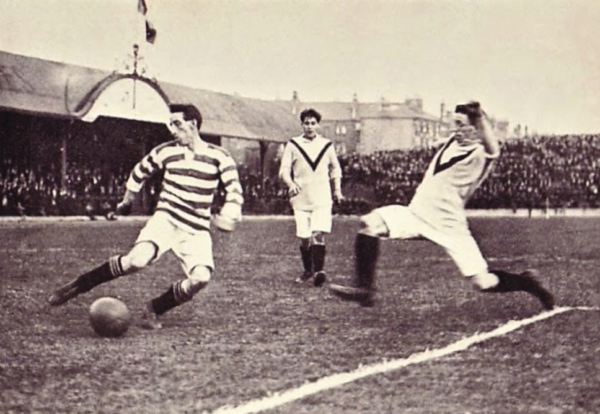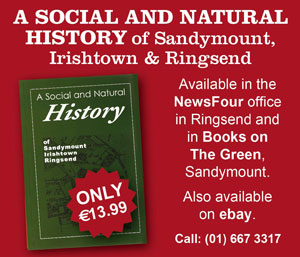
Gavan Bergin
Patrick ‘Patsy’ Gallagher was born in Milford Workhouse in Co. Donegal in 1891. He spent the first few years of his life living in Ramelton, a small village on the shores of Loch Swilly.
When he was three, he emigrated with his family to Scotland. They settled in Clyde-bank, where Patsy grew up brilliant at playing football. His gift for the game was clear from the time he was made the captain and star player of his primary-school team.
From then on, Patsy looked certain to make it as a professional footballer – he kept improving as a player and by the time he was school-leaving age he was known as one of the best young players in the Glasgow area.
But, although his talent and skill were obvious to anyone who saw him play, profession-al clubs didn’t fancy Patsy be-cause he was relatively small. Full-grown he was five foot seven inches tall and weighed less than nine stone.
His physique was described as ‘undernourished’ and ‘puny’. In modern football that would not be a matter for any great concern, but in the rough, often violent, environment of British football in those days, talent scouts often overlooked smaller players. So, despite his abilities as a player, by the time he finished school Patsy still hadn’t been signed up by any professional club.
At the age of nineteen, he was working as an apprentice in the Clyde shipyards while playing part-time for the junior team of Clydebank FC. His big chance came when he was offered a trial by Glasgow Celtic. Patsy didn’t waste that opportunity. He scored five goals in two trial games! Unsurprisingly, that was enough to earn him a professional contract and he signed with Celtic in November 1911.
That same November, he made his debut for them in a Scottish Division One game against St Mirren. His performance in that game showed that he was good enough to play at the highest level of Scottish football. During the remaining months of that 1911/12 season, he played an-other ten matches and scored three goals including one goal that sealed victory for Celtic in the 1912 Scottish Cup Final.
Patsy was an exceptionally skillful, inventive and effective forward player and he quickly became a favourite with the Celtic supporters, showing that he had the talent to make it as a top player. Patsy also proved beyond any doubt that he could hack the physical side of professional football.
He was much stronger than he looked and was not bothered by any rough treatment doled out by opposing defenders, as was confirmed by the Celtic Star magazine: “Any-one who treated Gallagher badly got his own medicine back, nor did it matter the size, the bigger they were, the hard-er they fell.” Such was Patsy’s energetic, powerful style and deceptive strength that he was given the nickname of ‘the Mighty Atom’.
After his promising start with Celtic, he did even better in his next season, becoming a first-team regular and scoring 12 goals in 35 matches during 1912/13. By the end of that second season he had become Celtic’s first choice player in the inside-right forward position. Thereafter, Patsy continued to play outstanding at-tacking football to help Celtic get back to being the top team in Scotland again.
When Patsy had joined them Celtic were undoubtedly the second-best side in the country, having been comprehensively overshadowed by a particularly fine Glasgow Rangers side that won the league every year between 1911 and 1913. But that spell of dominance by Rangers was the last they would enjoy for quite some time. In 1913/14 Celtic were champions again after Patsy’s 22 goals in 38 games helped them win the Scottish League and Cup double. That achievement was the first of many for team and player. Between 1913 and 1917, Patsy scored 89 goals in 138 games and helped Celtic win the League four years running.
Then, in 1918 Celtic finished second to Rangers, and although they won the title back in 1919, they lost it again the following year and then faded from pre-eminence.
During the 1920s, they were forced to play second fiddle to one of the greatest-ever Rangers teams which, managed by the legendary Bill Struth, went on to win the League eight times in nine seasons.
Although Celtic were dominant no more, Patsy was still the most thrilling forward player in Scottish football and he remained an integral player for his team well past his thirtieth birthday. Between 1921 and 1926 he scored 42 goals in 144 matches and won the Scottish League and the Scottish Cup twice each.
And it was during that late period of his Celtic career that Patsy scored two goals of such astonishing brilliance that it is no wonder that almost 100 years later they are still being written about.
The first of them came in Celtic’s match away to Hibernian in 1921, when Patsy scored a flawless solo goal. He took the ball from kick-off in the centre circle and ran with it, through the entire Hibs team before shooting to score without anyone else get-ting a touch of the ball prior to the Hibernian keeper when he picked it out of his net.
That was a phenomenal strike indeed and, if only it existed on film, it would undoubtedly be as well-known as other classic ‘one man on the run’ goals from the age of televised football, such as those scored by Maradona against England in 1986, or by George Weah against Verona in 1996.
Yet, as amazing as Patsy’s goal against Hibernian in 1921 was, four years later he got a score that was even more stunning and which became the goal that is most often cited as perfect evidence of his football genius. That goal was scored for Celtic against Dundee in the 1925 Scottish Cup Final, a match which was reported in the London Times under the headline “Magic Moments in the Scottish Cup Final 1925 from the World’s Greatest Soccer Player, Patsy Gallagher”.
Patsy had looked nothing like that in the first stages of the final, and neither he nor the other Celtic players seemed likely to get anything from the match. They were sluggish and off the pace and Patsy looked every one of his 34 years, while Celtic looked every inch a side that was well past its peak.
But their opponents were a different story. Dundee were lively, positive and playing extremely well in all areas of the game. They might have gone into the match as underdogs who hadn’t won the Cup for fifteen years, but they were fully in control early on in the game and their domination was underlined when they scored the game’s opening goal late in the first half. Dundee held their lead at half-time and they looked to have every chance of taking home the Cup.
But in the second half the Glasgow team woke up. As the Times said “Dundee were leading 1-0 and despondency was creeping into the Glasgow Celtic fans when Patsy Gallagher, as so often before, produced a moment of pure elation. Getting the ball just inside the Dundee half, he rolled past challenge after challenge, sometimes appearing in danger of toppling over as he swerved and swayed dangerously close to the ground. No Dundee boot or body could stop him completely as he veered, sure foot as a young deer, towards their goalmouth. Finally, a heavy, desperate tackle grounded him inside the six-yard box. Patsy hit the ground and for an instant his brave effort seemed to be at an end. But Patsy had not yet parted company with the ball, which remained between his feet. A quick somersault and both Patsy and the ball ended up entangled in the Dundee net for the most unorthodox goal in a Scottish Cup Final. ‘There was something magical, something out of this world about it,’ the Dundee players said. It was the greatest feat of skill and determination they had ever seen on a football field. That barely believable goal livened Celtic up and put some fire back in their attacking moves as they pushed forward until the last minute when they scored again… and won the Cup.”
(Part two of Patsy Gallagher, the Mighty Atom will appear in the December 2020/January 2021 issue of NewsFour).



